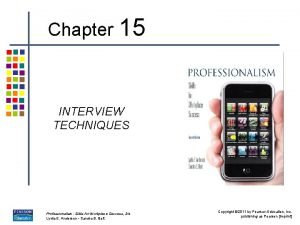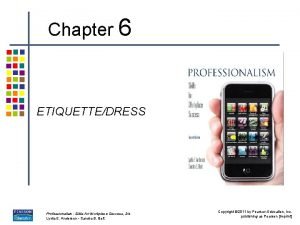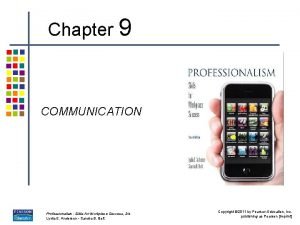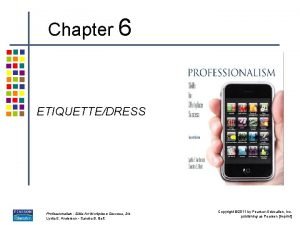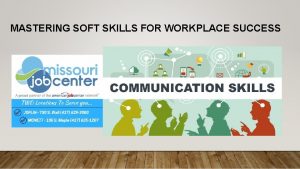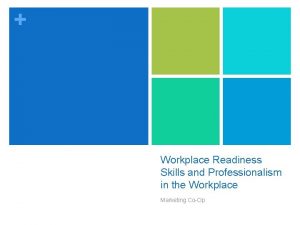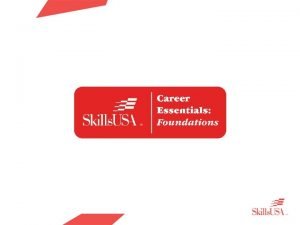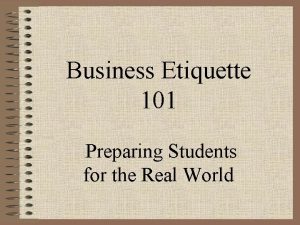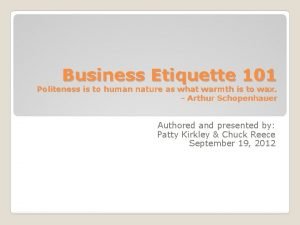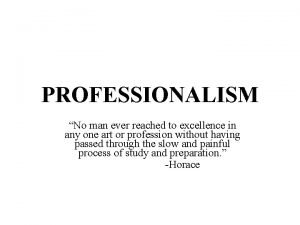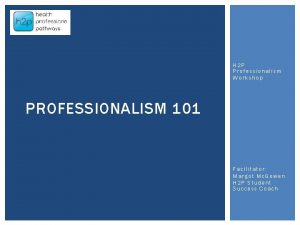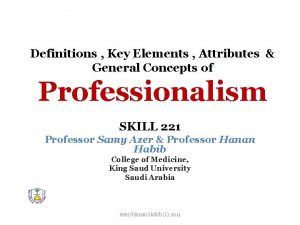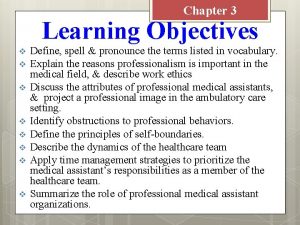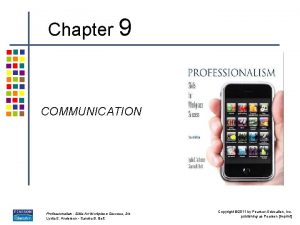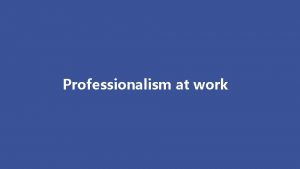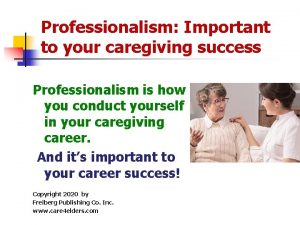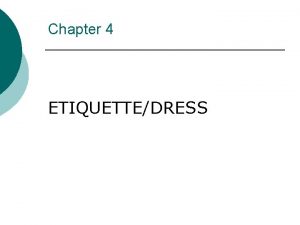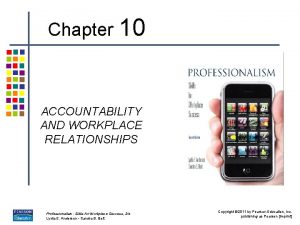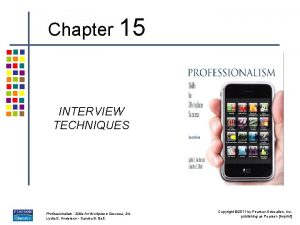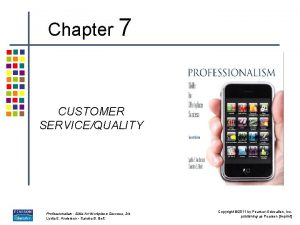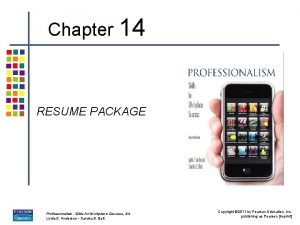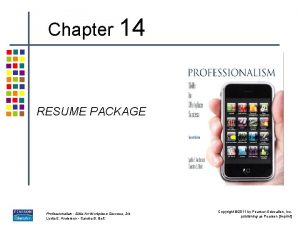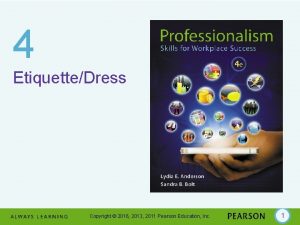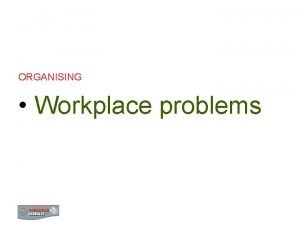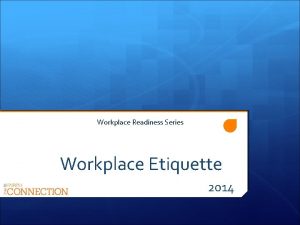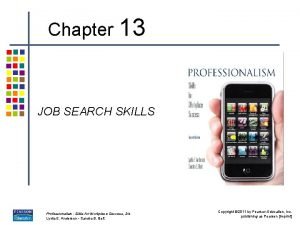Chapter 6 ETIQUETTEDRESS Professionalism Skills for Workplace Success




























- Slides: 28

Chapter 6 ETIQUETTE/DRESS Professionalism: Skills for Workplace Success, 2/e Lydia E. Anderson • Sandra B. Bolt Copyright © 2011 by Pearson Education, Inc. publishing as Pearson [imprint]

OBJECTIVES 1. Describe and discuss the importance of professional behavior in your career 2. State the impact dress can have on others’ perception of you 3. Demonstrate a professional and correct introduction and handshake 4. Demonstrate appropriate professional behavior in business dining situations 5. Recognize and apply the appropriate use of technology in business/social situations 6. Utilize professional etiquette in appropriate business situations Professionalism: Skills for Workplace Success, 2/e Lydia E. Anderson • Sandra B. Bolt Copyright © 2011 by Pearson Education, Inc. publishing as Pearson [imprint]

EXECUTIVE PRESENCE • Executive presence: having the attitude of an executive • This shows you have knowledge about basic workplace behavior • Be prepared for the social experiences you will face in the workplace Professionalism: Skills for Workplace Success, 2/e Lydia E. Anderson • Sandra B. Bolt Copyright © 2011 by Pearson Education, Inc. publishing as Pearson [imprint]

INFLUENCES OF DRESS IN A PROFESSIONAL ENVIRONMENT • Appearance: how you look • The majority of first impressions are made through your visual appearance • Appearance has an impact on how you perform at work • Think of your appearance as a frame; it is there only to highlight the picture Professionalism: Skills for Workplace Success, 2/e Lydia E. Anderson • Sandra B. Bolt Copyright © 2011 by Pearson Education, Inc. publishing as Pearson [imprint]

INFLUENCES OF DRESS IN A PROFESSIONAL ENVIRONMENT Appropriate Dress • Dress code: a policy that addresses issues such as required attire, uniforms, and hairstyle • Work wardrobe: clothes primarily worn only to work and work-related functions – Simple, solid skirts for women – Dark slacks and a matching jacket for men • Develop a style that conforms to both company policy and your taste Professionalism: Skills for Workplace Success, 2/e Lydia E. Anderson • Sandra B. Bolt Copyright © 2011 by Pearson Education, Inc. publishing as Pearson [imprint]

TIPS FROM HEAD TO TOE • Shower daily and use deodorant • Use lotions, cologne, or perfume sparingly • Clothes should be clean and ironed, and they should fit properly • Hair should be clean, well kept, and a natural color • It is not acceptable to wear suggestive clothing • Hands and nails should be well-groomed • Jewelry should be kept to a minimum • Shoes should be in good condition Professionalism: Skills for Workplace Success, 2/e Lydia E. Anderson • Sandra B. Bolt Copyright © 2011 by Pearson Education, Inc. publishing as Pearson [imprint]

TALK IT OUT Your friend is invited to deliver a speech at the meeting with Saigon. Tech and HCC’s staff. Give your friend some tips (from head to toe) to have appropriate appearance. Professionalism: Skills for Workplace Success, 2/e Lydia E. Anderson • Sandra B. Bolt Copyright © 2011 by Pearson Education, Inc. publishing as Pearson [imprint]

JEWELRY, BODY PIERCING, AND TATTOOS • Body piercings and body rings/jewelry may be offensive to some individuals • It is difficult to hide a tattoo • Consider the long-term consequences if you are thinking about getting a tattoo • Nose rings, lip rings, and/or tongue rings should not be worn in a professional setting • More than two earrings worn on each ear is considered unprofessional Professionalism: Skills for Workplace Success, 2/e Lydia E. Anderson • Sandra B. Bolt Copyright © 2011 by Pearson Education, Inc. publishing as Pearson [imprint]

CASUAL WORKDAYS AND SPECIAL EVENTS • Casual workdays: days when companies relax their dress code • Still dress appropriately for work • More formal attire may be required for special work-related functions (e. g. customer service) • Avoid shirts with sayings or graphics that may offend others Professionalism: Skills for Workplace Success, 2/e Lydia E. Anderson • Sandra B. Bolt Copyright © 2011 by Pearson Education, Inc. publishing as Pearson [imprint]

TALK IT OUT Identify people in class who are wearing something appropriate for a casual workday Professionalism: Skills for Workplace Success, 2/e Lydia E. Anderson • Sandra B. Bolt Copyright © 2011 by Pearson Education, Inc. publishing as Pearson [imprint]

HANDSHAKES • A good handshake conveys confidence 1. Make eye contact and smile 2. Extend your right hand 3. Meet at the web; 4. Grip the other person’s hand 5. Gently squeeze and shake hands Professionalism: Skills for Workplace Success, 2/e Lydia E. Anderson • Sandra B. Bolt Copyright © 2011 by Pearson Education, Inc. publishing as Pearson [imprint]

HANDSHAKES § Do not squeeze too firmly § Shake the entire hand, not just the fingers § Do not place your hand on top of the other person’s hand or pat the hand § If your palms are sweaty, discretely wipe your palm on the side of your hip prior to shaking Professionalism: Skills for Workplace Success, 2/e Lydia E. Anderson • Sandra B. Bolt Copyright © 2011 by Pearson Education, Inc. publishing as Pearson [imprint]

DINING Dining Etiquette • Place your napkin on your lap; if you need to leave the table, place your napkin to the side of your plate • As courses are served, start with the outside utensil and work in, toward the plate; the utensils set at the top of the plate are for your dessert • With beverages, offer and serve others at your table prior to serving yourself • Do not order alcohol unless others at your table first order an alcoholic beverage; abstaining from alcohol is the most desired behavior Professionalism: Skills for Workplace Success, 2/e Lydia E. Anderson • Sandra B. Bolt Copyright © 2011 by Pearson Education, Inc. publishing as Pearson [imprint]

4. DINING Dining Etiquette (cont. ) • Do not order anything expensive or messy • Offer bread to others at your table before taking a piece for yourself • Offer the last piece of bread or appetizer to others before taking it • Begin eating only when everyone at your table has been served; if everyone receives their meal except you, give others at your table permission to begin eating without you Professionalism: Skills for Workplace Success, 2/e Lydia E. Anderson • Sandra B. Bolt Copyright © 2011 by Pearson Education, Inc. publishing as Pearson [imprint]

4. DINING Dining Etiquette (cont. ) • Do not eat your meal with your fingers unless your main course can be eaten without utensils • If you accidentally burp or slurp, immediately apologize and say “excuse me” • When done eating, place your knife and fork together with the blade facing in and the tines up; when you are resting and do not want the server to take your plate, place tines facing down • It is inappropriate to use a mobile device while dining; if you must take a call, excuse yourself from the table Professionalism: Skills for Workplace Success, 2/e Lydia E. Anderson • Sandra B. Bolt Copyright © 2011 by Pearson Education, Inc. publishing as Pearson [imprint]

DINING Dining Etiquette (cont. ) • R. S. V. P. means “please respond” – Send a reply, whether you are accepting the invitation or sending your regrets • When attending a social functional with other professionals, remember: – Refrain or limit the consumption of alcohol – Only serve yourself a small plate of hors d’oeuvres and move away from the food table – Hold your hors d’oeuvres in your left hand, leaving your right hand free to shake hands and greet others – Do not talk with food in your mouth Professionalism: Skills for Workplace Success, 2/e Lydia E. Anderson • Sandra B. Bolt Copyright © 2011 by Pearson Education, Inc. publishing as Pearson [imprint]

TALK IT OUT Share common dining and social situations that make you uncomfortable and identify how best to deal with these situations Professionalism: Skills for Workplace Success, 2/e Lydia E. Anderson • Sandra B. Bolt Copyright © 2011 by Pearson Education, Inc. publishing as Pearson [imprint]

TECHNOLOGY AT WORK Mobile Communication Devices • Turn off or silence your device when attending a meeting • If you are anticipating an emergency call, place on vibrate • Do not use devices while dining or while attending meetings & performances • Do not take or make a text or call in front of others; instead, excuse yourself and step away for privacy Professionalism: Skills for Workplace Success, 2/e Lydia E. Anderson • Sandra B. Bolt Copyright © 2011 by Pearson Education, Inc. publishing as Pearson [imprint]

TECHNOLOGY AT WORK Phone Etiquette • Communicate properly through the words you choose, tone of voice, pitch of voice, and rate of speech • Convey a positive, friendly attitude • Speak clearly and slowly • Phone calls are for brief interactions Professionalism: Skills for Workplace Success, 2/e Lydia E. Anderson • Sandra B. Bolt Copyright © 2011 by Pearson Education, Inc. publishing as Pearson [imprint]

TECHNOLOGY AT WORK Phone Etiquette-Speakerphones • Speakerphones are useful communication tools • Should only be used for conference calls when other participants are in the same room or when you require a hands-free device • Only use in a private room where call will not be distracting to others • Make introductions to all included in call • Avoid distracting noises Professionalism: Skills for Workplace Success, 2/e Lydia E. Anderson • Sandra B. Bolt Copyright © 2011 by Pearson Education, Inc. publishing as Pearson [imprint]

TECHNOLOGY AT WORK Phone Etiquette – Taking a Call • When answering a call, answer by the second ring • When others are present, let call go into voice mail • If you are expecting a call and others are present, inform those present that you will need to take the call • Politely tell individuals when they will be placed on hold Professionalism: Skills for Workplace Success, 2/e Lydia E. Anderson • Sandra B. Bolt Copyright © 2011 by Pearson Education, Inc. publishing as Pearson [imprint]

TECHNOLOGY AT WORK Phone Etiquette-Messages • Keep phone messages brief • State your name, the purpose of the call, and your return phone number • Speak slowly and clearly • Repeat your name and return number at the end of your message • Promptly return phone messages • Keep your voicemail greetings professional Professionalism: Skills for Workplace Success, 2/e Lydia E. Anderson • Sandra B. Bolt Copyright © 2011 by Pearson Education, Inc. publishing as Pearson [imprint]

TECHNOLOGY AT WORK E-mail and Computer Usage • • Use only for business purposes Emoticons are inappropriate at work Do not forward non-work-related messages Check spelling & grammar before sending a response • Respond to messages requesting a reply • Include the business subject in the subject line to let the receiver know it is not junk email or a virus • Proofread and think about a message before pressing reply to ensure proper interpretation Professionalism: Skills for Workplace Success, 2/e Lydia E. Anderson • Sandra B. Bolt Copyright © 2011 by Pearson Education, Inc. publishing as Pearson [imprint]

BUSINESS ETIQUETTE Terms • Etiquette: a standard of social behavior as seen by society • Courtesy: exercising manners, respect, and consideration toward others • Respect: holding someone in high regard; putting others’ needs before your own needs Professionalism: Skills for Workplace Success, 2/e Lydia E. Anderson • Sandra B. Bolt Copyright © 2011 by Pearson Education, Inc. publishing as Pearson [imprint]

BUSINESS ETIQUETTE Please and Thank You • These are extremely powerful words that can create power for you at work • When someone does something nice for you, say “thank you” • Make it a habit to write a thank-you note when someone does something for you Professionalism: Skills for Workplace Success, 2/e Lydia E. Anderson • Sandra B. Bolt Copyright © 2011 by Pearson Education, Inc. publishing as Pearson [imprint]

BUSINESS ETIQUETTE Demeanor • Have a positive attitude • Make eye contact and smile • Make introductions when necessary – Introduce the least important person to the most important person first • Keep appointments on time • Be kind and polite • Do not ignore an appointment; if you must cancel, apologize Professionalism: Skills for Workplace Success, 2/e Lydia E. Anderson • Sandra B. Bolt Copyright © 2011 by Pearson Education, Inc. publishing as Pearson [imprint]

TALK IT OUT Discuss ways you can be courteous and respectful in class Professionalism: Skills for Workplace Success, 2/e Lydia E. Anderson • Sandra B. Bolt Copyright © 2011 by Pearson Education, Inc. publishing as Pearson [imprint]

OTHER ETIQUETTE BASICS • • • Knock before entering an office Put others first—allow others to go first No Interrupting—rude behavior Apologize—everyone makes mistakes Avoid dominating a conversation—the key is listening • Do not swear in the workplace Professionalism: Skills for Workplace Success, 2/e Lydia E. Anderson • Sandra B. Bolt Copyright © 2011 by Pearson Education, Inc. publishing as Pearson [imprint]
 Professionalism skills for workplace success
Professionalism skills for workplace success Professionalism: skills for workplace success
Professionalism: skills for workplace success Professionalism skills for workplace success
Professionalism skills for workplace success Professionalism skills for workplace success
Professionalism skills for workplace success Communication skills for workplace success
Communication skills for workplace success Your child's success or lack of success
Your child's success or lack of success Your child's success or lack of success
Your child's success or lack of success Workplace readiness skills- positive work ethics
Workplace readiness skills- positive work ethics Ctecs workplace readiness skills answer key
Ctecs workplace readiness skills answer key Workplace readiness skills for the commonwealth
Workplace readiness skills for the commonwealth Workplace readiness test answers
Workplace readiness test answers Quizlet
Quizlet Planning and organising skills in the workplace
Planning and organising skills in the workplace Workplace readiness skills for the commonwealth
Workplace readiness skills for the commonwealth Workplace readiness skills answers
Workplace readiness skills answers Cornell skills for success
Cornell skills for success Success criteria for listening skills
Success criteria for listening skills Success criteria for listening skills
Success criteria for listening skills Business etiquette 101: social skills for success download
Business etiquette 101: social skills for success download Business etiquette 101: social skills for success indireme
Business etiquette 101: social skills for success indireme Skills that are essential to self-employment success
Skills that are essential to self-employment success Growing success 2010
Growing success 2010 No professionalism
No professionalism Domain 4 showing professionalism examples
Domain 4 showing professionalism examples Discuss principles of professionalism
Discuss principles of professionalism Professionalism workshop
Professionalism workshop What are the 3 key elements of professionalism
What are the 3 key elements of professionalism Summarize three obstructions to professionalism
Summarize three obstructions to professionalism Professionalism definition
Professionalism definition
